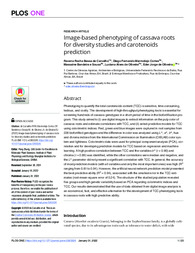Image-based phenotyping of cassava roots for diversity studies and carotenoids prediction.
Image-based phenotyping of cassava roots for diversity studies and carotenoids prediction.
Author(s): CARVALHO, R. R. B. de; CORTES, D. F. M.; SOUSA, M. B. e; OLIVEIRA, L. A. de; OLIVEIRA, E. J. de
Summary: Phenotyping to quantify the total carotenoids content (TCC) is sensitive, time-consuming, tedious, and costly. The development of high-throughput phenotyping tools is essential for screening hundreds of cassava genotypes in a short period of time in the biofortification program. This study aimed to (i) use digital images to extract information on the pulp color of cassava roots and estimate correlations with TCC, and (ii) select predictive models for TCC using colorimetric indices. Red, green and blue images were captured in root samples from 228 biofortified genotypes and the difference in color was analyzed using L*, a*, b*, hue and chroma indices from the International Commission on Illumination (CIELAB) color system and lightness. Colorimetric data were used for principal component analysis (PCA), correlation and for developing prediction models for TCC based on regression and machine learning. A high positive correlation between TCC and the variables b* (r = 0.90) and chroma (r = 0.89) was identified, while the other correlations were median and negative, and the L* parameter did not present a significant correlation with TCC. In general, the accuracy of most prediction models (with all variables and only the most important ones) was high (R2 ranging from 0.81 to 0.94). However, the artificial neural network prediction model presented the best predictive ability (R2 = 0.94), associated with the smallest error in the TCC estimates (root-mean-square error of 0.24). The structure of the studied population revealed five groups and high genetic variability based on PCA regarding colorimetric indices and TCC. Our results demonstrated that the use of data obtained from digital image analysis is an economical, fast, and effective alternative for the development of TCC phenotyping tools in cassava roots with high predictive ability.
Publication year: 2022
Types of publication: Journal article
Unit: Embrapa Cassava & Fruits
Keywords: Mandioca
Observation
Some of Embrapa's publications are published as ePub files. To read them, use or download one of the following free software options to your computer or mobile device. Android: Google Play Books; IOS: iBooks; Windows and Linux: Calibre.
Access other publications
Access the Agricultural Research Database (BDPA) to consult Embrapa's full library collection and records.
Visit Embrapa Bookstore to purchase books and other publications sold by Embrapa.

